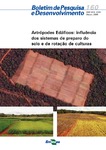Please use this identifier to cite or link to this item:
http://www.infoteca.cnptia.embrapa.br/infoteca/handle/doc/570260Full metadata record
| DC Field | Value | Language |
|---|---|---|
| dc.contributor.author | OLIVEIRA, C. M. de | pt_BR |
| dc.contributor.author | RESCK, D. V. S. | pt_BR |
| dc.contributor.author | FRIZZAS, M. R. | pt_BR |
| dc.date.accessioned | 2011-07-08T11:52:25Z | - |
| dc.date.available | 2011-07-08T11:52:25Z | - |
| dc.date.created | 2007-07-13 | pt_BR |
| dc.date.issued | 2006 | pt_BR |
| dc.identifier.citation | Planaltina, DF: Embrapa Cerrados, 2006. | pt_BR |
| dc.identifier.uri | http://www.infoteca.cnptia.embrapa.br/infoteca/handle/doc/570260 | pt_BR |
| dc.description | RESUMO: Este trabalho objetivou avaliar a influência de sistemas de preparo de solo e de rotação de culturas e pastagem na abundância e dinâmica de artrópodes edáficos. O experimento, instalado em Planaltina, DF, foi composto por 17 tratamentos que corresponderam a sistemas de preparo de solo (convencional e direto) e a rotação de culturas, pastagem e vegetação nativa (Cerrado). Realizaram-se amostragens de solo em três profundidades (0-5 cm, 5-10 cm e 10-20 cm) e em quatro épocas do ano (fevereiro, maio, agosto/setembro e outubro/novembro) entre 2003 e 2006. Os artrópodes foram extraídos em funil de Berlese-Tüllgren e identificados com relação à ordem. Coletaram-se artrópodes pertencentes a três classes: Insecta, Arachnida e Collembolla. Observou-se que 81,5 % dos espécimes pertenciam à ordem Acari e que 86,9 % do total de artrópodes foram coletados na camada de 0-10 cm. No Cerrado, observou-se a maior abundância de artrópodes, seguido pelo sistema de plantio direto com uso de safrinha e o sistema de preparo convencional com escarificador. O monocultivo proporcionou menor abundância de artrópodes em relação à rotação de culturas. Houve uma tendência de aumento populacional de artrópodes na época de maior precipitação. ABSTRACT: The objective of this study was to evaluate the influence of soil tillage and crop rotation systems and pasture on the frequency and dynamics of soil arthropods. The experiment, located at Planaltina, Federal District, Brazil, was composed by 17 treatments correspondent to the different soil tillage systems (conventional and no till) and crop rotation or pasture, and na tive vegetation (Cerrado). Soil samples were taken at three depths (0-5 cm, 5-10 cm and 10-20 cm) and in four periods of the year (February, May, August/September, and October/November) during 2003- and 2006-period. The arthropods were extracted by using a Berlese- Tüllgren funnel and identified at the order level. Among Insecta, Arachnida and Collembolla classes colected it was observed that 81.5 % of the arthropods specimen belong to the Acari order and about 86.9 % of the total were colected in the 0-10 cm-layer. Under Cerrado, it was found the highest frequency of arthropods, followed by no till system using a cover crop, and the chisel system. The lowest frequency of arthropods was found in treatments using a single crop when compared to crop rotation. There was a tendency of arthropods population increase during the highest precipitation season. | pt_BR |
| dc.language.iso | por | pt_BR |
| dc.relation.ispartofseries | (Embrapa Cerrados. Boletim de Pesquisa e Desenvolvimento, 160). | pt_BR |
| dc.rights | openAccess | pt_BR |
| dc.title | Artrópodes edáficos: influência dos sistemas de preparo do solo e de rotação de culturas. | pt_BR |
| dc.type | Folhetos | pt_BR |
| dc.date.updated | 2011-07-08T11:52:25Z | pt_BR |
| dc.subject.thesagro | Dinâmica Populacional | pt_BR |
| dc.subject.thesagro | Entomologia | pt_BR |
| dc.subject.thesagro | Gramínea | pt_BR |
| dc.subject.thesagro | Inseto | pt_BR |
| dc.subject.thesagro | Leguminosa | pt_BR |
| dc.subject.thesagro | Manejo do Solo | pt_BR |
| dc.subject.nalthesaurus | entomology | pt_BR |
| dc.subject.nalthesaurus | grasses | pt_BR |
| dc.subject.nalthesaurus | legumes | pt_BR |
| dc.subject.nalthesaurus | population dynamics | pt_BR |
| dc.subject.nalthesaurus | soil management | pt_BR |
| dc.format.extent2 | 25 p. | pt_BR |
| riaa.ainfo.id | 570260 | pt_BR |
| riaa.ainfo.lastupdate | 2009-10-21 | pt_BR |
| Appears in Collections: | Boletim de Pesquisa e Desenvolvimento (CPAC)  | |
Files in This Item:
| File | Description | Size | Format | |
|---|---|---|---|---|
| bolpd160.pdf | 799.84 kB | Adobe PDF |  View/Open |









